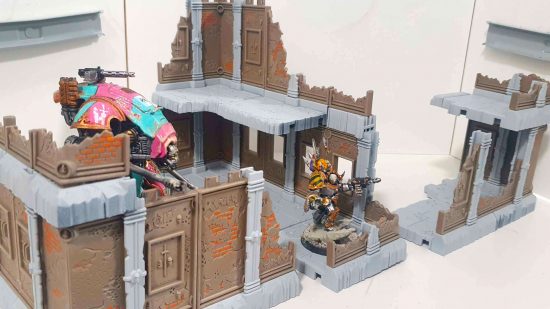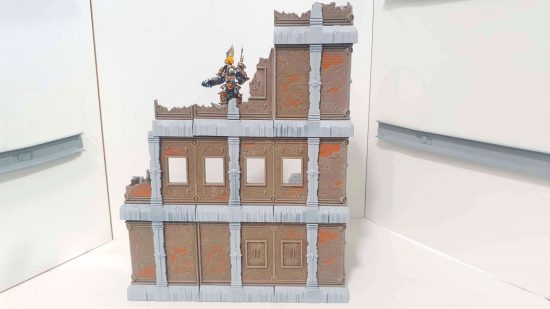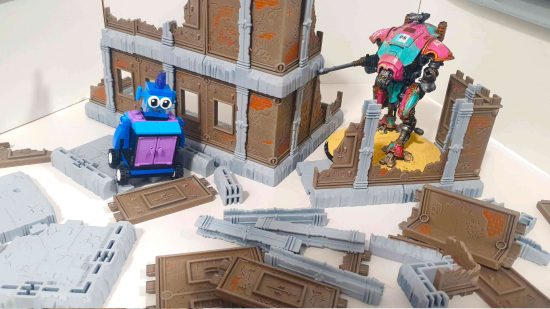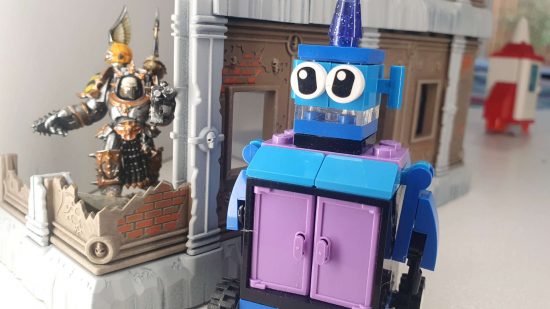Our Verdict
Easy to paint, easy to build, easy to store, and as modular as Lego, FutureProof Terrain is a perfect solution for Warhammer 40k players, tournament organisers, and game clubs.
- Goes together like Lego, no glue required
- Sturdy once built
- Can be reconfigured into different layouts as needed
- Packs away for compact storage
- 3D details make dry-brushing easy and effective
- Setting-agnostic aesthetics - will work for sci-fi, fantasy, and some historical settings
- This is gaming terrain, not realistic scenery
- So far, only one style
- The overall flexibility of layouts will be limited by the size of your collection
FutureProof Modular Terrain, currently raising funds on Kickstarter, might be the best Warhammer 40k terrain system yet developed. It achieves something I’ve never seen before: gaming terrain that can be taken apart and put back together as easily as Lego, yet is sturdy and stable enough to hold your models during a game.
Lots of terrain gets advertised as being ‘modular’: Games Workshop’s Mechanicus and Zone Mortalis terrain for Warhammer 40k or the whole of the Legions Imperialis terrain line, Archon Studios’ Dungeons and Lasers building and dungeon tiles for DnD miniatures, Mantic Games’ Deadzone urban ruins scenery, and so on.
But if you want those kits to be sturdy enough to stand up to extended use, you have to permanently glue them together. FutureProof Terrain doesn’t need glue. Floor tiles connect to one another with concealed jigsaw joints, while walls and pillars have push-fit connections at both ends that go into sockets on the tops and bottoms of the floor tiles. The fit between pieces is snug and secure.

Buildings can be broken down completely for storage, always handy, but the real selling point for competitive gamers, tournament organisers, and game clubs is the ability to easily reconfigure the footprint and height of your terrain.
The same set of components could be line of sight blocking buildings for competitive Warhammer 40k, teetering hive towers for Necromunda, and urban ruins for Bolt Action. When a new edition changes the recommended terrain layout for a game, you can just rebuild your terrain to match.

The 3D surface detail on the terrain is fairly subtle – enough that you can easily give the terrain definition with a spray paint basecoat and a quick drybrush and wash, but not so much that you’ll feel like you’re missing out if you don’t paint the details. Getting paint on the push-fit tabs will make the connections a little tight, which can be avoided by masking the tabs off before painting, or corrected by scraping the paint off afterwards.
The design of the pieces is setting agnostic, with no definitively sci-fi or even modern elements. There’s a gothic skull motif that will obviously suit the Warhammer 40k factions, but I’ve painted my demo set up to look a bit like a Boston redbrick terrace, in anticipation of Fallout: Factions. I can imagine Marvel: Crisis Protocol players getting a kick from pulling out walls, mid-game, and replacing them with ruins, when the Hulk punches Red Skull into the next county.

This terrain is a complete success on its own terms. It may not be the right choice for you as a player, for reasons I’ll address, but that won’t be because of any failure of the product, but because it’s doing one thing really well and not trying to do anything else. Before you run off and back the Kickstarter, I will highlight the few caveats I have.
There’s a massive market of digital terrain files for 3D printing, many of them modular, others bespoke but highly detailed – but the process of making the parts is time consuming and potentially messy. It’s a hobby in and of itself: if you value flexibility over speed and consistency that might appeal more than this new terrain system. We have a guide on how to 3D print miniatures and the best 3D printers for miniatures if that’s the way you’d rather go.
The range of components available at the moment is sufficient but not expansive. Limiting the scope of a product’s first release is a sensible choice, and there’s enough variety on offer to build a number of different ruins layouts; but the joy of Lego sets comes in part from the plethora of different pieces you can plug in. So far everything is locked to a square grid, and there isn’t even a piece for a door.
There’s also just one aesthetic. This terrain makes ruins that look most at home in modern to gothic sci-fi settings, and a few fantasy genres; useful in a lot of games, but not all of them. More variety would be great to see in future expansions.
This is definitely gaming terrain, not miniature scenery. For some people, the joy of wargaming comes from the spectacle of two tiny armies fighting it out over gorgeous terrain, whether that’s an immaculate recreation of the Tractor Factory in Stalingrad, the looming half-timber ruins of the fantasy city Mordheim, or a vibrant xenos jungle. FutureProof Terrain looks great, but it’s not trying to be immersive – it is a bit gamey.
The actual flexibility you’ll have with your builds will also depend on how much of this stuff you buy. But now we’re just quibbling: the same could be said of Lego, or frankly any other terrain range.
Overall, FutureProof Modular Terrain is a slam dunk. I’m very excited by this new terrain system, and can’t wait to see how it expands in the future.

